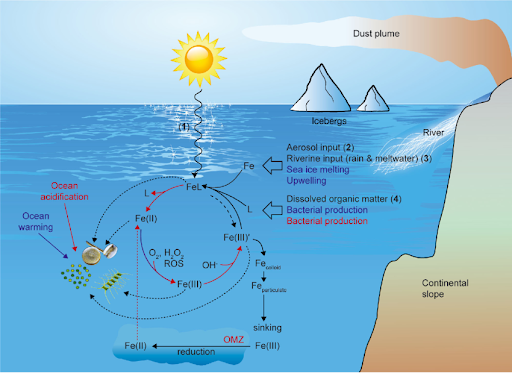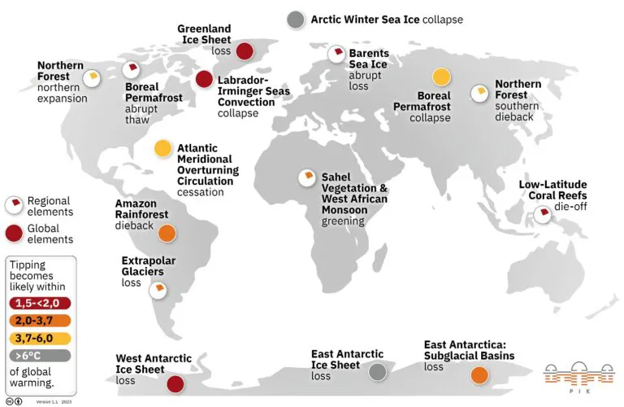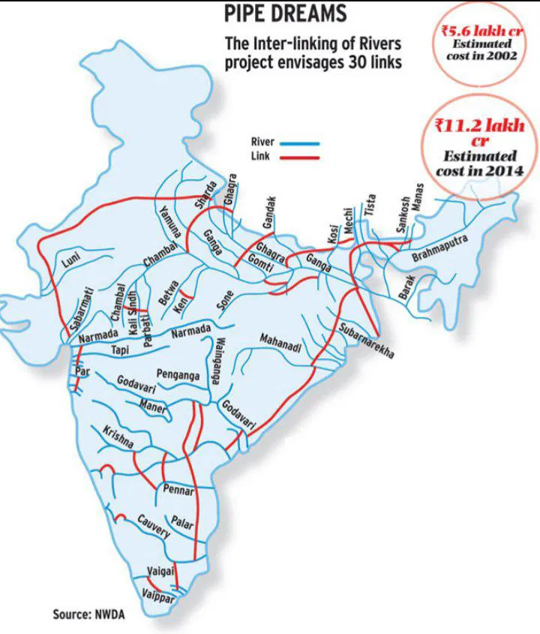10 Oct to 24 Oct, 2024
BLACK CARBON FOOTPRINT OF HUMAN
Why in news? : Black carbon (BC) from fossil fuel and biomass combustion darkens the snow and makes it melt sooner. The BC footprint of research activities and tourism in Antarctica has likely increased as human presence in the continent has surged in recent decades.
About :
Introduction:
In an era where environmental consciousness is of paramount importance, the black carbon footprint emerges as a complex and multi-dimensional challenge. Black carbon, commonly referred to as soot, is a fine particulate matter produced from incomplete combustion of fossil fuels, biomass, and other organic materials. It is a significant contributor to global warming, air pollution, and adverse health effects.
Natural causes of Black Carbon :
- Wildfires: Wildfires inject large amounts of black carbon (BC) particles into the atmosphere, which can reach the lowermost stratosphere (LMS) and cause strong radiative forcing. Black Carbon Emissions from the Siberian Fires in 2019 impacting the entire Arctic region.
- Volcanic Eruptions: Black carbon emissions due to volcanic eruption of Mount St. Helens in the United States in 1980 dispersed over long distances by wind patterns.
- Biomass Burning: Natural events like lightning strikes can ignite biomass, such as forests or grasslands, leading to the release of black carbon and other smoke particles. Eg Amazon rain forest fires in South America.
- Vegetation Decay: Black carbon emissions due to vegetation decay is found in peatlands. A notable example is the draining and degradation of peatlands in Southeast Asia, particularly in Indonesia
- Dust Storms: Wind-blown dust particles can mix with soot and become black carbon aerosols. One notable example is the "Asian Dust" phenomenon, also known as the "Yellow Dust" or "Yellow Sand," which occurs in East Asia.
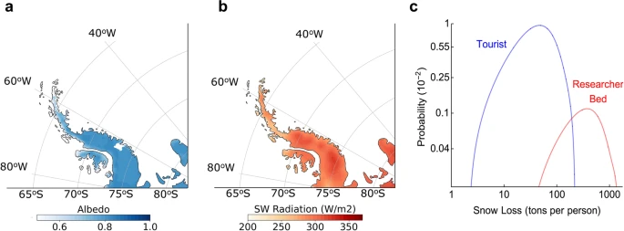
Black Carbon (BC) from local activities in Antarctica darkens the snow and makes it melt sooner.
Anthropogenic causes of Black Carbon:
- Fossil Fuel Combustion: According to the USA, fossil fuel combustion accounted for approximately 25% of the black carbon emissions in the country.
- Transportation: In 2016, the Indian Institute of Technology (IIT) Delhi conducted a study and found that transportation was a major source of black carbon emissions in Delhi.
- Waste Incineration: Burning of waste in open dumps or poorly controlled incineration facilities can emit black carbon and other pollutants.
- Residential Energy Use: In the Himalayan state of Uttarakhand and Himachal, many households rely on traditional cooking stoves that burn solid fuels like wood, agricultural residues, and dung for their daily cooking needs, significantly contributing in black carbon emissions.
- Deforestation and Land Use Changes: Researchers from the Woods Hole Research Center and the University of California, Irvine, found that deforestation and associated land use changes were responsible for significant black carbon emissions in the Amazon basin.
Significant Impacts of Black Carbon:
- Human Health : Black carbon is a major component of fine particulate matter (PM2.5). Inhalation of PM2.5 can lead to respiratory and cardiovascular problems, particularly in vulnerable populations such as children and the elderly.
- Climate Change: Black absorbs sunlight and contributes to regional and global warming, influencing the Earth's energy balance and climate patterns. As black carbon settles on the Himalayan glaciers, it accelerates their melting rates.
- Agriculture and Food Security: Black carbon in the atmosphere can reduce sunlight reaching crops, leading to lower photosynthesis rates and potentially reducing crop yields. Crops like rice, wheat, and maize can be particularly affected, impacting food production and availability. Black carbon can alter regional weather patterns, including the timing and intensity of monsoon rains.
- Ecosystems and Biodiversity: Black carbon deposition in Arctic soils affects the temperature and moisture regimes of the soil. This, in turn, can alter the microbial communities living in the soil, which play critical roles in nutrient cycling.
- Tourism and Industry : Poor air quality resulting from black carbon emissions can deter tourists from visiting certain areas, impacting local tourism-based economies. Study finds an increased concentration of black carbon in Gangotri region during tourist seasons.
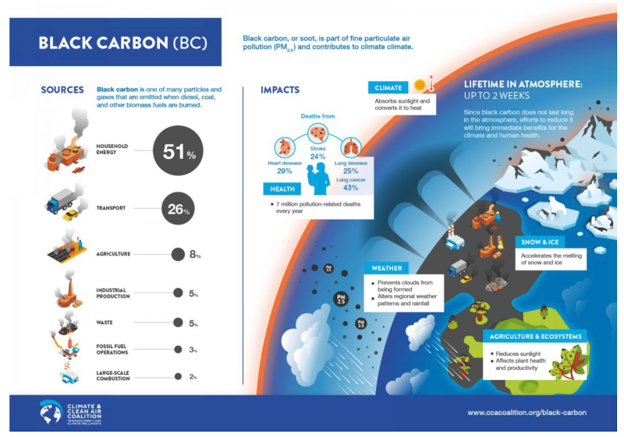
|
CASE STUDY : ARCTIC BLACK CARBON The Arctic has become a hotspot for black carbon research as it is playing a crucial role in warming and the strong heating effect . The presence of black carbon on ice and snow surfaces reduces their albedo, causing them to absorb more sunlight. This process, known as "Arctic Amplification," accelerates ice melt, leading to the shrinking of Arctic sea ice and glaciers. Study found a direct correlation between black carbon deposition and glacier retreat rates . Black carbon can darken the surface of permafrost, increasing heat absorption and accelerating permafrost thaw. Thawing permafrost releases greenhouse gasses, further contributing to global warming. Reduced sea ice and changes in sea ice dynamics can also affect the timing and availability of food for Arctic marine animals. Black carbon aerosols can alter atmospheric circulation patterns and contribute to shifts in weather patterns with implications for local communities dependent on traditional activities like hunting and fishing. |
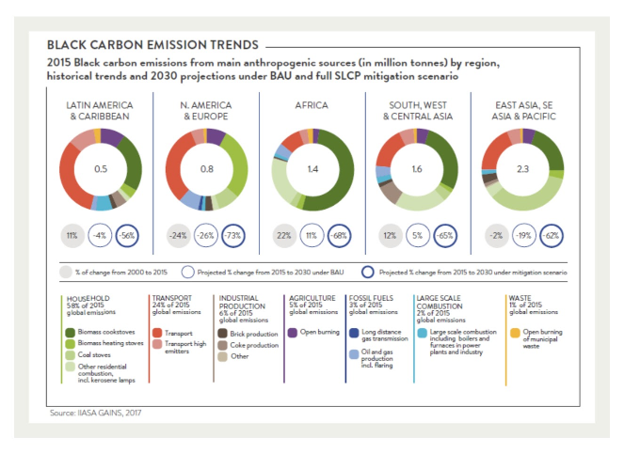
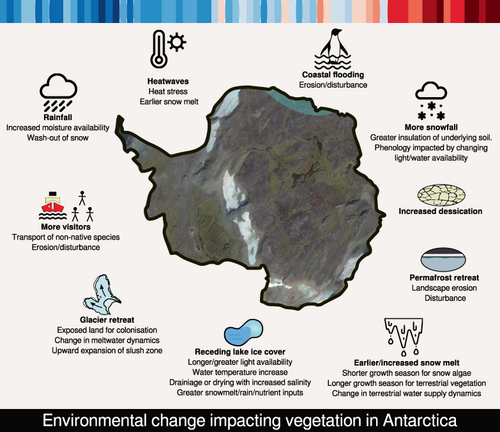
How Black Carbon Disturbs the Heat Budget of the Earth ?
- Absorption of Solar radiation: Black carbon particles when released into the atmosphere, intercept solar radiation and convert it into heat. This process reduces the albedo , warms the surrounding air and contributes to the overall heating of the atmosphere.
- Disruption of Atmospheric Stability: Black carbon in the atmosphere can alter the vertical temperature profile, reducing the stability of the atmosphere. This can impact cloud formation and weather systems, leading to changes in precipitation patterns and atmospheric circulation.
- Affecting Clouds: Black carbon particles can act as cloud condensation nuclei, influencing the formation and properties of clouds. This can lead to changes in cloud behavior, potentially affecting cloud cover and cloud lifetimes, and ultimately impacting the Earth's energy balance.
- Affecting Ocean Circulation : Melting of ice due to black carbon deposition can lead to changes in ocean circulation patterns. As fresh meltwater enters the ocean, it can disrupt the balance of salinity and density, affecting ocean currents and heat distribution.
- Ocean Warming: Black carbon contributes to the heating of the atmosphere when it absorbs sunlight. As the atmosphere warms, it can transfer some of this heat to the ocean through increased evaporation and ocean-atmosphere heat exchange.
Activities undertaken by selected GEF( Global Environment Facility ) Implementing Agencies and other international organizations towards mitigating Black Carbon.
|
GEF Implementing Agency |
Activity |
|
World Bank |
• Engaged in reducing BC emissions from the brick sector in South Asia • Assessed potential BC mitigation approaches to reduce impacts on cryosphere regions |
|
United Nations Environment Programme (UNEP) |
• Hosts the Partnership for Clean Fuels and Vehicles.
|
|
United Nations Industrial Development Organization (UNIDO) |
|
SOLUTIONS TO MITIGATE THE EMISSIONS OF BLACK CARBON
- Cleaner Energy Sources: Transitioning from fossil fuels to cleaner energy sources, such as renewable energy (solar, wind, hydroelectric) and natural gas, can significantly reduce black carbon emissions from power generation, industrial processes, and residential heating. India's initiative to switch from BS IV to BS VI engine vehicles is commendable .
- Improved Cooking Technologies: Promoting the use of improved cookstoves and clean fuels (e.g., LPG, biogas) for cooking can help reduce black carbon emissions from traditional biomass burning in households. The Government of India introduced PMUY ( Pradhan Mantri Ujjawala Yojana ) offers BPL households a cash contribution of Rs 1600 for each LPG connection.
- Advanced Emission Control Technologies: Installing and maintaining advanced emission control devices, such as particulate filters and scrubbers, can help capture black carbon and other pollutants from exhaust gases. WAYU (Wind Augmentation PurifYing Unit) was developed to address air pollution at traffic intersections and dense traffic zones.
- International Cooperation: Addressing black carbon emissions requires collaboration between countries, especially for transboundary pollution. International agreements and partnerships can support collective efforts to mitigate black carbon emissions.
Conclusion
- The measures to prevent black carbon emissions can reduce near-term warming of the climate, increase crop yields and prevent premature deaths.
- Black carbon’s short atmospheric lifetime, combined with its strong warming potential, means that targeted strategies to reduce emissions can provide climate and health benefits within a relatively short period of time.
Source :
https://www.science.org/doi/10.1126/sciadv.adp1682
Where to use :
Paper I ( Geography Optional ) : Climatology
Paper III ( General Studies ): Climate change and its impacts, Permafrost areas .
GROUND WATER AS A BUFFER : MYTH OR REALITY
Why in news : According to the Indian Institute of Technology Gandhinagar, Gujarat, replacing approximately 40% of the land currently used for rice cultivation with alternative crops could potentially restore 60-100 cubic kilometers of groundwater that has been depleted in northern India since 2000.
About
Groundwater accounts for about 30% of the Earth's freshwater supply, and the remaining 70% is stored in ice caps and glaciers.Over 2.5 billion people depend on groundwater for daily drinking water, including about 60% of people in rural areas. Nearly 40% of global irrigation water is sourced from groundwater, making it a key resource for food security.
Countries with the highest groundwater abstraction rates include India, China, and the United States. India alone accounts for over 25% of global groundwater extraction, mainly for irrigation purposes.In the Middle East and North Africa, over 70% of water supply comes from non-renewable groundwater sources.
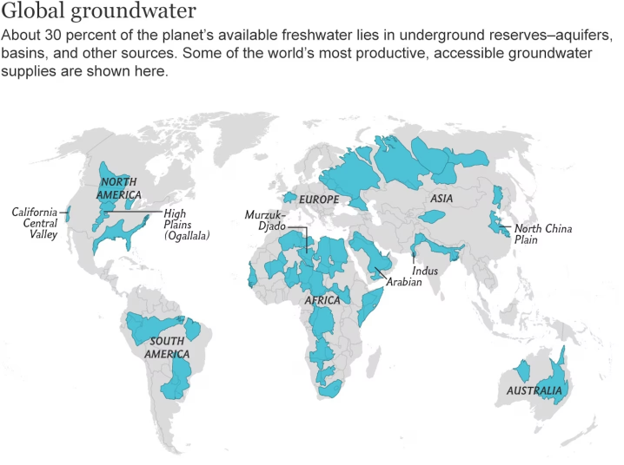
Challenges Associated with Groundwater
- Hydrological imbalance: Over Extraction leads to an imbalance between recharge and discharge rates. Unsustainable extraction disrupts the natural recharge of groundwater through precipitation, contributing to water scarcity.
- Groundwater contamination : Nitrate contamination affects more than 60% of India's groundwater resources. In regions like Uttar Pradesh and Maharashtra, nitrates from fertilizers are a major issue. Arsenic contamination is widespread in the Ganges-Brahmaputra-Meghna (GBM) plain, affecting millions of people in states like West Bengal, Bihar, and Assam.
Groundwater as a Buffer: Reality or Myth
Reality
- Acts as a Natural Reserve During Dry Periods : In India, about 80% of rural domestic water and 60% of agricultural irrigation is sourced from groundwater, particularly in drought-prone regions like Maharashtra and Rajasthan.
- Groundwater Storage and Managed Aquifer Recharge (MAR) : Australia has implemented MAR to great effect in places like South Australia and Perth, where surplus surface water is stored in underground aquifers during wetter seasons and withdrawn during dry periods.
Myth
- Contamination Limits Usability : Coastal saline intrusion, as seen in Tamil Nadu, has reduced the usability of groundwater, particularly in coastal villages relying on it during the dry season.
- Groundwater as an Unsustainable Long-term Solution : In California, the Central Valley aquifer's overuse has led to land subsidence, which now threatens the integrity of the entire groundwater system, limiting its buffering capacity in future droughts.
Methods of Conservation
- Traditional Practices: Traditional Tanks such as Baoli, Tanka, stepwells, Khadins in Rajasthan, Eri system of tamilnadu, Rani ki Vav in Gujarat, Bamboo drip irrigation, Kul system of Himachal Pradesh, etc.
- Conventional Methods: check dams, well recharge, contour ploughing, percolation pits , watershed management , canal and flood irrigation.
- Under the Neeranchal National Watershed Project , the emphasis was on creating watershed assets for the Integrated Watershed Development Programme.
Government Initiatives
- Jal Shakti Abhiyan for water conservation and water security in identified water stressed blocks.
- National Water Mission was launched with an aim to improve water efficiency by 20%
- Atal Bhujal Yojana, a World Bank aided project , was launched for groundwater management in selected states.
- Composite Water Management Index (CWMI) by Niti Aayog was developed to enable effective water management in Indian States.
- Jal Jeevan Mission envisioned to provide safe and adequate drinking water through individual household tap connections by 2024 to all households in rural India.
- The One Water approach is a holistic method that combines planning and implementation to effectively manage limited water resources for long-term sustainability and dependability.

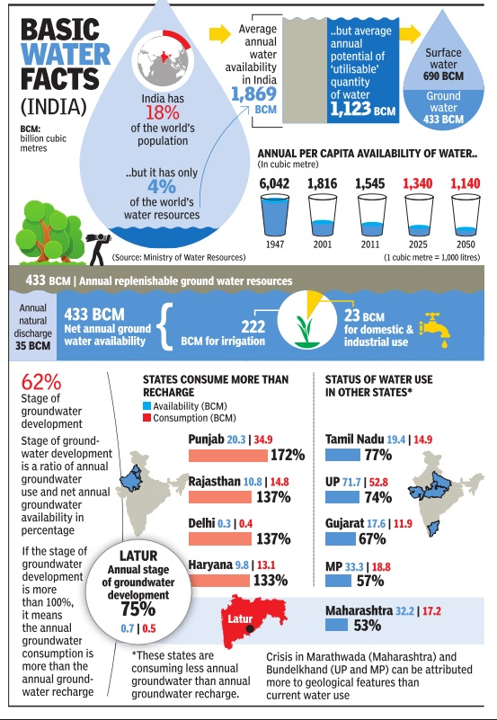
Conclusion
With proper management, techniques like artificial recharge, and water-saving agricultural practices, groundwater can still serve as a viable buffer resource in the future. The reality of groundwater as a buffer depends on geographical regions, management practices, and extraction-recharge balance, making it crucial to adopt sustainable policies to preserve its potential buffering role.
Source :
Where to use :
Paper II ( Geography Optional ) : Resources
CLIMATE CHANGE DISRUPTS METHANE
Why in news : New research from the University of São Paulo highlights how climate change could disrupt greenhouse gas dynamics in the Amazon rainforest, with significant global consequences.
About :
Key Sources of Methane Emissions
- Agriculture (Enteric Fermentation) : Methane is produced as a by-product of digestion in ruminant animals like cows, sheep, and goats. Cattle are responsible for around 30% of methane emissions from human-related activities globally.
- Landfills and Waste Management: Decomposition of organic waste in landfills without oxygen leads to the production of methane. Landfills account for about 11% of methane emissions worldwide.
- Wetlands : Natural wetlands produce methane due to the anaerobic decomposition of organic material in waterlogged conditions.The Amazon rainforest and Siberian tundra wetlands are key methane-producing regions.
- Permafrost Thawing : Thawing of permafrost in polar regions releases methane stored in frozen organic matter. This is a rising concern due to climate change, as permafrost thawing could significantly increase methane emissions in the future.
How Global Warming Can Impact Methane Cycle?
- Imbalance in Sources and Sinks : In a balanced system, methane sources would be offset by sinks, similar to CO₂. Scientists are concerned that as the Earth warms, more methane could be released from soils and other reservoirs, intensifying global warming.
- Methane Clathrates : Methane clathrates form in cold, oxygen-poor sediments under the sea and in permafrost. These clathrate hydrates resemble water ice, with methane molecules trapped within water crystals.
- Role of Clathrate Deposits : Previously, clathrate deposits acted as methane sinks, but with rising global temperatures, some are melting and releasing methane. This released methane, a potent greenhouse gas, further accelerates global warming.
How Can We Balance the Methane Cycle?
- Enhanced Landfill Design : The Puente Hills Landfill in California, USA, captures over 8 million cubic feet of methane daily and converts it into electricity, powering 70,000 homes.
- Livestock Management : Studies show that adding red seaweed (Asparagopsis taxiformis) to cattle feed can reduce methane emissions by up to 80% in ruminants.
- Aerobic Treatment Methods : The city of Durban, South Africa, uses an aerobic digestion system for wastewater treatment, reducing methane emissions by 90% compared to traditional anaerobic methods.
- Rice Cultivation Practices : Alternate wetting and drying (AWD) methods in rice farming can cut methane emissions by 30-50%, as demonstrated in pilot projects in the Philippines and Vietnam.
- Soil Health Management : The use of biochar and organic compost in soil management practices in India has led to a 30% reduction in methane emissions from paddy fields, while improving soil fertility.
- Safe Extraction Practices : Japan's 2013 test project extracted methane from undersea hydrates in the Nankai Trough, demonstrating a potential methane hydrate resource of 1.1 trillion cubic meters, but safe extraction technologies are needed to avoid methane leaks.
- Reducing Fossil Fuel Use : The shift to renewables like solar and wind could reduce methane emissions from the energy sector by 50% by 2050, according to a study by the International Energy Agency (IEA).

Where to use :
Paper I ( Geography Optional ) : Climate change
Paper III ( General Studies ) : Environment Conservation
Antibiotic pollution
Antibiotic pollution : Antibiotic pollution occurs when antibiotics are released into the environment, usually through waste from pharmaceutical industries, hospitals, and agricultural runoff. This pollution can lead to the development of antibiotic-resistant bacteria, which poses a major threat to public health and ecosystems.
Pioneer Species
Pioneer Species : Pioneer species are the first organisms to colonize barren or disturbed environments, such as after a volcanic eruption or forest fire. They are typically hardy species, like lichens or mosses, that prepare the environment for more complex life by improving soil quality and adding organic matter.
Greywater recycling
Greywater recycling : Greywater recycling is the process of collecting and reusing water from household sources like sinks, showers, and washing machines (excluding toilet water). This recycled water can be used for irrigation, toilet flushing, or other non-drinking purposes, helping conserve fresh water.
Upland forests
Upland forests : Upland forests are ecosystems found in higher elevation areas, typically on hills or mountains. These forests often have distinct vegetation and wildlife due to cooler temperatures, well-drained soils, and steeper slopes, playing a key role in water regulation and biodiversity.
Clathrate deposits
Clathrate deposits : Clathrate deposits are structures where gases, such as methane, are trapped in ice-like cages of water molecules. These deposits are found beneath the ocean floor and in permafrost regions, and they hold vast amounts of methane, a potent greenhouse gas, which can be released due to warming, contributing to climate change.
GREAT BARRIER REEF CORAL
In 2016, the Great Barrier Reef (GBR) experienced the most severe coral bleaching in recorded history, yet, as in previous 1998 and 2002 events, the severity and spatial extent of coral bleaching were variable. Cyclonic activity mitigated warming effects in the southern GBR, meaning corals in this region were predicted to bleach less; as a result, southern reef areas received little attention. Surveys of 14 reefs revealed paling of coral colonies at every site. A total of 21% of living coral, primarily Pocillopora and branching Acropora, was affected. Findings suggest that southern reefs were affected by warming, although significantly less than in the north.
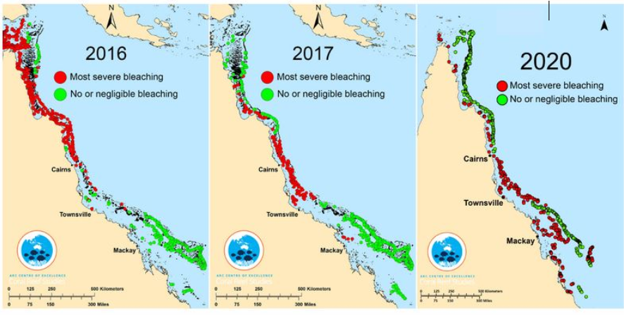
Source :
Paper I ( Geography optional ): Coral reefs and bleaching
Paper III ( General Studies ) : Climate change and Global warming
Places in News - 24 October 2024
1. Hirakud Lake
Why in news: The six-decade-old canal system connected to Odisha's Hirakud Dam is set for a major renovation.
- Hirakud Dam is located around 15 kilometers from Sambalpur in the state of Odisha, across the Mahanadi River.
- The dam creates the Hirakud Reservoir, also known as Hirakud Lake. It is Asia's largest man-made lake.
- Cattle Island is a small island located within the Hirakud Reservoir.
- Approx : Sambalpur
2. Jujumara
Why in news : The Jujumara region in Odisha's Sambalpur district is home to one of the first Farmer Producer Organizations (FPO) in the state dedicated exclusively to floriculture.
- Jujumura is a block under Sambalpur district of Odisha.
- Regions favorable climate fosters floriculture in these areas.
- Approx : Sambalpur
3. Ranthambore Tiger Reserve
Why in news : The Rajasthan forest department has stopped the illegal construction of a complex within the buffer zone of Ranthambore Tiger Reserve, in Rajasthan.
- It lies in the eastern part of Rajasthan state in Karauli and Sawai Madhopur districts, at the junction of the Aravali and Vindhya hill ranges.
- The vegetation includes grasslands on plateaus and dense forests along the seasonal streams.
- It was once a royal hunting ground for the Maharajas of Jaipur.
- The Rivers Chambal in the south and the Banas River in the north bound the tiger reserve.
- Approx : Sawai Madhopur
4. Merak
Why in news : Recently, auroras were sighted in lower-latitude regions (below 66.5 degrees north and south latitudes) like India (Hanle and Merak in Ladakh), Mexico and Germany.
- Merak is a village on the southern banks of Pangong Tso, near Spangmik on the south India-China border in the Leh District, Ladakh.
- In 2018, a telescope was installed to study solar chromosphere at Indian Astronomical Observatory, Merak.
- Approx : Leh
5. Dandeli forest
Why in news: The Dandeli forest faces substantial environmental shifts due to changing climate patterns and human interventions.
- It is located in the Uttara Kannada district of Karnataka and is part of the Western Ghats, a globally recognized biodiversity hotspot.
- The Kali Tiger Reserve is a protected area adjacent to the Dandeli Forest.
- Approx: Uttara Kanada
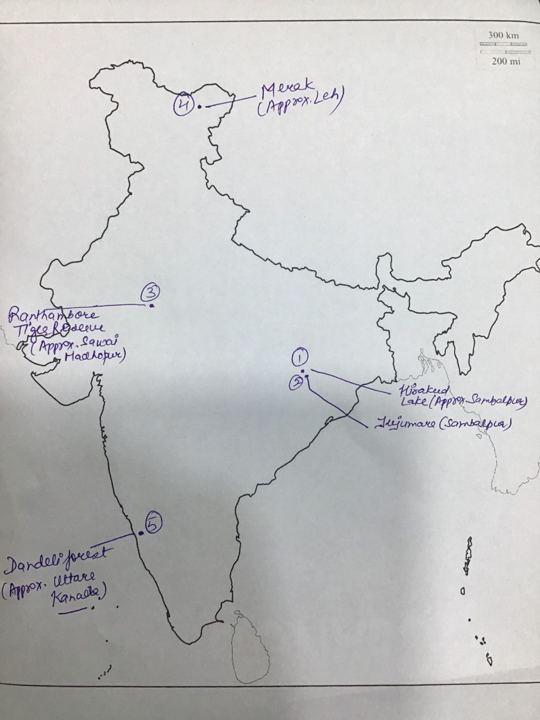
Fortnightly KOSMOS MCQs Practice - 24th October 2024
Q1. With reference to the Karman Line, consider the following statements:
- The Karman Line represents a conceptual demarcation set 100 km above the Earth's surface, distinguishing between our planet's atmosphere and the vastness of space.
- The Karman Line's establishment traces back to the 1960s by NASA, the space organization of the United States.
Which of the statements given above is/are not correct?
- Only 1
- Only 2
- Both 1 and 2
- Neither 1 nor 2
Q2. Consider the following pairs:
State Tribes
- Arunachal Pradesh a. Mismi
- Assam b. Khasis
- Nagaland c. Zeliang
Which of the pairs given above is/are correctly matched?
- One pair
- Two pairs
- Three pairs
- None
Q3. The Toto dialect, used by a mere 1,600 individuals, is nearing extinction. In which region is this Toto dialect predominantly used?
- Bhutan
- Assam
- West Bengal
- Sikkim
Q4. Which of the following protected areas are present within the Nilgiri Biosphere Reserve?
- Mudumalai Wildlife Sanctuary
- Wayanad Wildlife Sanctuary
- Bandipur National Park
- Nagarhole National Park
Select the correct answer using the code given below:
- One statement
- Two statements
- Three statements
- Four statements
Q5. With reference to Dandeli Forest, consider the following statements:
- Dandeli forest is located in the central part of India.
- The Kawal Tiger Reserve is a protected area adjacent to the Dandeli Forest.
- The invasive Eupatorium weed is replacing native grasses in the forest.
How many of the statements given above are correct?
- One only
- Two only
- Three only
- None
Q6. With reference to the Ganga River Dolphins, consider the following statements:
- They use ultrasonic noises to hunt, with these sounds reflecting off fish and potential prey, allowing them to form a mental picture.
- These creatures exclusively inhabit freshwater environments and have very limited vision.
- This species is recognized as India's national aquatic animal and also as the aquatic emblem of Assam.
How many of the above statements are correct?
- Only one
- Only two
- All three
- None
Q7. With reference to Tibetan Plateau in Asia,consider the following statements:
- Tibet holds the record as the planet's most elevated area, boasting a mean altitude of 6,900 meters.
- The peak of Mount K2 stands as the tallest point in Tibet.
- In 2023, authorities from Tibet put their signatures on a document, under the direction of China, referred to as the “Seventeen Point Agreement.”
How many of the statements given above are correct?
- Only one
- Only two
- All three
- None
Q8. With reference to the amphibians, consider the following statements:
- These creatures are complex vertebrates that inhabit both terrestrial and aquatic environments.
- They represent the initial ectothermic animals to establish a presence on land.
- As ectothermic beings, amphibians adjust their internal body heat in response to environmental shifts.
How many of the above statements are not correct?
- Only one
- Only two
- All three
- None
Q9. With reference to the Stratospheric Aerosol Intervention (SAI), consider the following statements:
- SAI releases particles into the stratosphere, inducing a cooling outcome by reducing albedo.
- SAI is a suggested approach to solar geoengineering (or altering solar radiation) with the aim of mitigating global temperature rise.
- Moderate levels of SAI might boost agricultural output in mid-latitude zones such as North America and Eurasia.
How many of the above statements are correct?
- Only one
- Only two
- All three
- None
Q10. With reference to the Dancing Frogs, consider the following statements:
- Dancing frogs refer to a set of frogs from the Micrixalus genus.
- The number of dancing frogs is declining due to introduction of non-native mosquito species
- These frogs favor areas with dense overhead foliage and are commonly located near gently flowing year-round streams in the Western Ghats.
How many of the above statements are correct?
- Only one
- Only two
- All three
- None
Share the article
Edukemy’s Current Affairs Quiz is published with multiple choice questions for UPSC exams
MCQ
Get Latest Updates on Offers, Event dates, and free Mentorship sessions.

Get in touch with our Expert Academic Counsellors 👋
FAQs
Geography Current Affairs focuses on the contemporary issues, events, and developments in the field of geography. It covers recent geographical phenomena, environmental changes, geopolitical shifts, and related news. This differs from regular geography studies which may focus more on foundational concepts, historical contexts, and theoretical frameworks.
Updates are provided regularly to ensure that subscribers stay informed about the latest developments in geography. Typically, updates are provided on a fortnightly basis, depending on the frequency of significant events and changes in the field.
Absolutely. Geography Current Affairs serves as a valuable resource not only for Geography optional but also for GS papers, especially GS Paper 1 (covering Indian Heritage and Culture, History, and Geography of the World and Society) and GS Paper 3 (covering Technology, Economic Development, Biodiversity, Environment, Security, and Disaster Management). It aids in building a holistic understanding of various topics and strengthens answer-writing skills by incorporating contemporary examples and perspectives.
Geography Current Affairs holds immense importance for UPSC preparation, particularly for aspirants opting for Geography optional. It helps candidates stay updated with the latest developments, geographical phenomena, environmental issues, and geopolitical shifts worldwide, aligning them with the dynamic nature of the subject as tested in the UPSC examinations.

